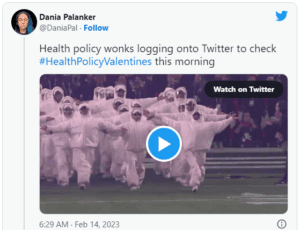Emerging Technologies Shaping the Health IT Landscape and How They Contribute to Improving Patient Outcomes and Healthcare Delivery
It’s been said many times before, but the truth remains the same: the world of healthcare is ever-evolving. We are learning and growing every day, which means we are also coming up with new ideas, technologies, and practices every day. But with all of this constant news of new technologies and changes in practices, it can be really tricky to stay on top of it all. To help, we reached out to our talented Healthcare IT Today Community and asked them: what emerging technologies in Health IT are currently shaping the landscape, and how do they contribute to improved patient outcomes and healthcare delivery? The following is what they had to share.
Scott Hondros, MHA, SCPM, Vice President of Services Commercialization & Strategy at CenTrak
Healthcare organizations aim to strengthen communication channels. Integrating RTLS visibility with patient workflow software allows automated text updates for patient-approved contacts, enhancing trust, clarity, and safety. RTLS can also enable proactive patient communication, sharing updates, wait times, and navigation instructions, guiding our approach for 2024. Workflow platforms utilizing RTLS data can monitor patient flow metrics, providing staff with precise patient location information throughout their care journey. Prioritizing comprehensive visibility for healthcare professionals will be key in the new year.
Robert Connely, Global Market Leader for Healthcare at Pega
Adaptive AI, a form of “narrow” AI, is transforming healthcare. In payer call centers, it swiftly onboards agents, cuts costs, and boosts satisfaction. The AI actively guides conversations, ensuring compliance. Leveraging health data, it engages patients in real-time, addressing issues that drive poor health and high utilization of health services. While it doesn’t capture the imagination like Generative AI, Adaptive AI delivers significant value, shifting focus from data to impactful health IT.
Stephen Sofoul, SVP, Data & Decision Science Services at MultiPlan
Advanced analytic solutions are changing the game for healthcare consumers. Last year, we saw the rise of artificial intelligence (AI) increase the size and complexity of data sets important to decision-making. In 2024, the focus will shift towards AI-enabled decision-making as advanced analytics will be used to identify actionable insights for patients, providers, and payers. For example, AI-enabled decision-making can inform clinical decisions, improve the accuracy of financial and clinical projections, and reduce the cost of healthcare through a data-driven approach.
Machine learning algorithms can constantly measure the difference between provider costs and their billed charges to help ensure fairness in the cost of care. Predictive modeling can foresee the need for future care services or procedures and help the provider address issues earlier in the patient’s healthcare journey, and the individual take preventative action, making more informed decisions around their cost and quality of care. The ability to drill in at a granular level with automation and advanced algorithms will continue to accelerate the move towards more “personalized” healthcare where recommendations are specific to the needs of the individual.
Tim Brennan, PMP, Senior Director, Healthcare IT and Operations Consulting at e4health
The IT revolution in healthcare over the past two decades has been overshadowed by a common complaint from physicians and providers – the incessant time spent on computer screens rather than connecting with patients. A promising trend emerging in health IT for 2024 is the integration of automation tailored for ambient documentation creation.
Ambient documentation creation holds the potential to alleviate this industry-wide complaint, enabling providers to concentrate on patient care while automating the laborious task of documenting interactions, while also proving highly valuable in mid-revenue operations. This technology facilitates the capture of clinical documentation during most patient engagements. From transcribing notes and interpreting documents for each specific use case to coding diagnoses for procedures and billing, ambient documentation technology is a valuable ally in alleviating the administrative burden placed on providers and physicians.
By significantly enhancing the accuracy of most clinical documentation, even capturing data through voice recognition, this trend is poised to usher in efficient operations, bolster financial outcomes, and, most importantly, allow physicians to focus fully on delivering superior patient care.
Baha Zeidan, CEO at Azalea Health
Hospitals and health providers want opportunities for simplified healthcare delivery. As many rural hospitals struggle to keep their doors open due to financial constraints, they can take advantage of a new Rural Emergency Hospitals (REH) designation. Though it is a relatively new program, Critical Access Hospitals are increasingly converting to the REH designation, which allows them to reduce services and continue operating with only outpatient and emergency services.
Healthcare management companies are helping streamline operations and service delivery to improve profitability, and in some cases, they purchase facilities. The simplified delivery models and systems they implement require a more lightweight technology package, and for Electronic Health Records (EHRs), this translates to a simple, cloud-based system.
Matt Cyr, VP, Group Director, Industry Strategists at Primacy
While 2023 was focused on ChatGPT and AI experimentation, 2024 is going to be all about the practical realities of embedding AI into complex healthcare organizations. This will include hospitals and health systems starting to answer the tough questions about AI’s impact on data privacy, copyrighted materials, and regulatory compliance. But it will also mean figuring out how AI can make healthcare more efficient and effective. Building from the Mayo Clinic’s successful pilot, I expect Microsoft 365 Copilot – which hands some mundane tasks like clinical documentation over to AI so clinicians can spend more time with patients – to explode into the mainstream in 2024.
Paul Brient, Chief Product Officer at athenahealth
It is no surprise that generative AI is making waves in the health IT landscape and holds a lot of promise to help mitigate the complexity of the healthcare system for both patients and clinicians. AI can help reduce the administrative burden on providers by helping them write responses to patients, compose draft notes, and even help with coding. It can also help them ensure they have all the patient information they need by digesting and providing easy access to unstructured data within an EHR, thus allowing them to access relevant data more easily at the moment of care.
This is just the beginning. Generative AI and AI in general are powerful tools that are getting more powerful by the day. No doubt, these technologies will play an increasing role in EHRs and the overall healthcare ecosystem. Of course, they’re not infallible and it is important to use the tech to supplement and power the clinical expertise and judgment of clinicians to ensure accurate, reliable, and ethical application in the healthcare setting.
Joseph Perekupka, CEO at Freespira
Digital therapeutics are emerging as the most transformative development in healthcare. I anticipate we’ll see the digital therapeutics market grow exponentially as they prove their clinical outcomes and deliver significant cost savings to health plans. Digital therapeutics are shifting the norms surrounding the traditional treatment paradigm and successfully changing the way patients access healthcare.
The convergence of technology with medicine brings the opportunity to diagnose and treat patients across a wide range of conditions with a validated solution at home. Digital therapeutic products are revolutionary in that they bring all three stakeholders together – payers, providers, and patients – and provide a clear pathway for improving the care patients receive regardless of ethnicity, gender, geography, or socioeconomic status.
Today in the U.S. 50% of people live in a designated mental health provider shortage area. Freespira addresses this clinician shortage by offering treatment for patients experiencing panic attacks and PTSD symptoms.
Harsh Singh, GM, Healthcare at Genzeon
Based on recent conversations, I anticipate a revolutionary transformation in healthcare in 2024 as organizations will publicly showcase measurable results from AI and Gen AI, propelling productivity gains of over 50% across areas of benefit administration, claims processing, provider interactions, member services, and clinical operations. The remarkable acceleration in adoption within the healthcare sector will outpace historical industry trends, showcasing a visible return on investment and substantial impacts on business models, unlike many other “silver bullet” initiatives of the past.
Mike Brandofino, President and COO at Caregility
We’ll see accelerated adoption of inpatient telehealth in 2024. The infusion of telehealth into acute care settings is giving rise to groundbreaking hybrid care models, seamlessly blending floor teams, remote clinicians, and AI to amplify clinical insights, bridge care gaps, and bolster patient safety. The dawn of inpatient virtual engagement heralds a transformative era in healthcare, promising an elevated experience for both patients and their care teams. Inpatient telehealth is poised to become an indispensable component of the Hospital Room of the Future, serving as a catalyst for future care model innovation.
Deepika Srivastava, EVP, Medical Professional Liability and Shared Services at The Doctors Company
As the healthcare landscape continues to evolve, artificial intelligence (AI) has the potential to be a powerful ally for healthcare professionals in ensuring the delivery of high-quality care in 2024. Recent studies suggest we are at a turning point in generative AI’s ability to transform healthcare, and 75 percent of healthcare executives agree. However, only six percent of those executives have implemented an AI strategy, according to a recent Bain & Company survey.
Integrating AI into healthcare is one of the most pivotal and pressing concerns for practitioners, hospitals, and the entire healthcare ecosystem. The potential of AI to revolutionize patient care, streamline processes, enhance diagnostic accuracy, and drive data-driven decision-making has elevated it to the forefront of healthcare’s most critical discussions. AI will not replace healthcare professionals, but it will augment their capabilities to provide superior patient care.
Yet, the focus has to be patient safety, as there are ethical considerations and potential new patient safety risks. For example, large language models sometimes ‘hallucinate’ and provide comprehensive answers to medical queries that appear convincing but may lack accuracy. It requires careful verification—not blind reliance on AI-generated content.
Wendy Deibert, CNO at Caregility
In 2024 I anticipate certifying bodies will advance efforts to establish virtual nurse certification programs that emphasize looking at data trending to help prioritize patient needs and identify appropriate opportunities for care transition and clinical intervention. Organizations like the American Academy of Colleges of Nursing and the Academy of Medical-Surgical Nurses are actively working with stakeholders within the nursing community to develop certification program criteria. This will help establish standards, trust, and support as Virtual Nursing programs gain momentum.
So many technologies to keep an eye on! Huge thank you to everyone who took the time to leave us a quote and thank you to all of you for reading this! We could not do this without your support. What emerging technologies do you see shaping the landscape of health IT and how are they contributing to improving patient outcomes and healthcare delivery? Let us know either in the comments down below or over on social media. We’d love to hear from all of you!
Get Fresh Healthcare & IT Stories Delivered Daily
Join thousands of your healthcare & HealthIT peers who subscribe to our daily newsletter.




